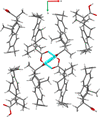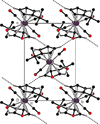issue contents
August 2024 issue

Cover illustration: The present paper reports the crystal structure of the polymeric complex catena-poly[[methanoldioxidouranium(VI)]-μ-2-[5-(2-oxidophenyl)-1H-1,2,4-triazol-3-yl]acetato-κ2O:O′], [UO2L(CH3OH)]n, where H2L is the versatile ligand 5-(2-hydroxyphenyl)-1H-1,2,4-triazol-3-yl acetic acid. Organic polydentate ligands capable of chelating uranyl ions are important for several applications, such as uranium waste management, recycling procedures and mining extraction processes. In the solid state, the compound shows a broad medium intensity LMCT transition centred around 463 nm, which is responsible for its red colour. See: Vashchenko, Khomenko, Doroshchuk, Stoica, Vassilyeva & Lampeka [Acta Cryst. (2024). E80, 852–856].
research communications



































 journal menu
journal menu





































